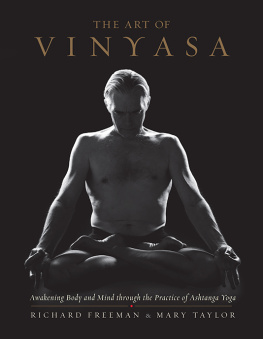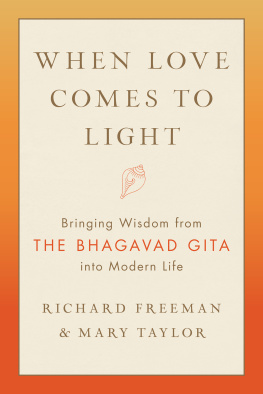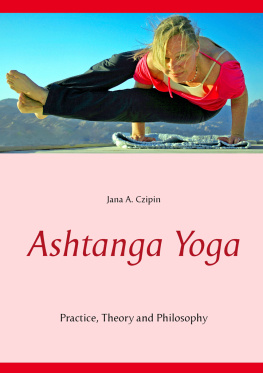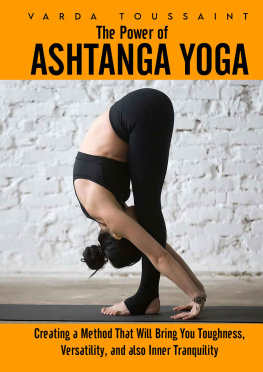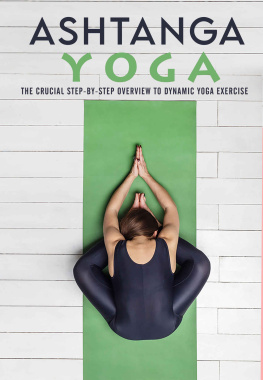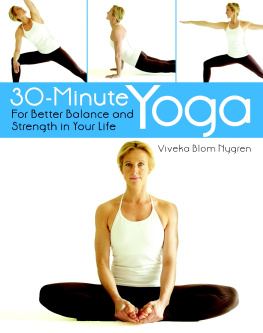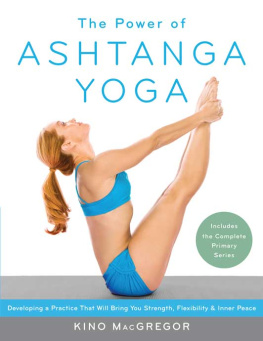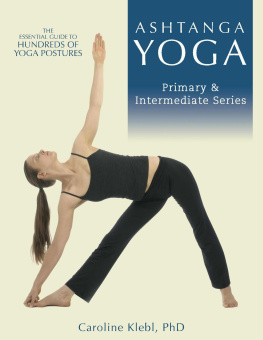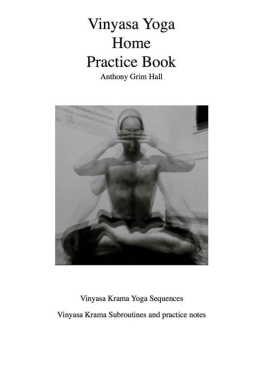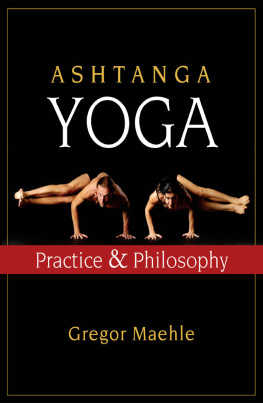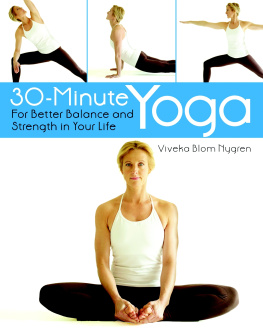Sign up to receive news and special offers from Shambhala Publications.

Or visit us online to sign up at shambhala.com/eshambhala.
THE ART OF
VINYASA

Awakening Body and Mind through the Practice of Ashtanga Yoga
RICHARD FREEMAN & MARY TAYLOR

SHAMBHALA
BOULDER
2016
Shambhala Publications, Inc.
4720 Walnut Street
Boulder, Colorado 80301
www.shambhala.com
Cover photos by Robert Muratore
Cover design by Jim Zaccaria
2016 by Richard Freeman and Mary Taylor
All rights reserved. No part of this book may be reproduced in any form or by any means, electronic or mechanical, including photocopying, recording, or by any information storage and retrieval system, without permission in writing from the publisher.
LIBRARY OF CONGRESS CATALOGING-IN-PUBLICATION DATA
Names: Freeman, Richard, 1950 author. | Taylor, Mary (Yoga teacher)
Title: The art of vinyasa: awakening body and mind through the practice of ashtanga yoga / Richard Freeman and Mary Taylor.
Description: Boulder: Shambhala, 2016. | Includes index.
Identifiers: LCCN 2016002192 | eISBN 9780834840409 | ISBN 9781611802795 (paperback)
Subjects: LSCH: Astanga yoga. | BISAC: HEALTH & FITNESS / Yoga. | PHILOSOPHY / Hindu.
Classification: LCC RA781.68 .F74 2016 | DDC 613.7/046dc23
LC record available at https://lccn.loc.gov/2016002192
To Sri K. Pattabhi Jois and his wife, Ammaji.
And with deep gratitude to Sarasvathi, Manju, and Sharath,
who continue to inspire us all in this practice.
This book is designed to shed light on establishing an internally rooted yoga practice that can last a lifetime. It also looks deeply at asana practice as an external expression of the internal forms that give a profound and direct experience to the awakening of body and mind through the practice.
CONTENTS
This book contains diacritics and special characters. If you encounter difficulty displaying these characters, please set your e-reader device to publisher defaults (if available) or to an alternate font.
Y OGA IS A LIVING ART. IT IS A MEANS OF MOVING, breathing, thinking, expanding and contracting, evolving and interacting within the complex, ever-changing landscape of the world within and around us. As with any art form, yoga nurtures seeds of aesthetic satisfaction that stimulate flashes of understanding and compassion. For many practitioners, a keen truth and meaning spontaneously arise as insight into the vast, interconnected nature of all things.
When embodied, these aesthetic sparks and seeds of insight are experienced as feelings of resonating with our surroundings. They occur in yoga when were not looking for themjust as they may when were standing in front of a great work of art or enjoying the perfect sunset. Somehow (possibly by chance) our perception of self is released just long enough for us to feel intimately connected to everything and everyone else, and the underlying field of kind, openheartedness that is our true nature naturally arises. Clarity or conscious awareness is the falloutthe residuefrom practicing yoga in this way, as an art rather than as a means of attaining this thing or that.
This approach to practice requires a willingness to invite and be with not knowing. It encourages us to show up ready and eager to meet whatever arises. Perhaps most important, it demands the mental and emotional agility to be comfortable with the paradox of simultaneously holding two or more points of view with equal attentiveness.
We learn to be focused and disciplined while letting go, surrendering the ego while steadying the mind, and all the while remaining tuned in to the complexity of whatever is arising. By cultivating open-minded states of inquisitiveness and acceptance in the controlled structure of a practice, encountering paradoxes and the unknown begins to feel safe, interesting, and exciting rather than tedious or frightening. Gradually habitual patterns of behavior and thinking dissipate as preconceptions dissolve and freedom unfolds.
This isnt what most of us sign up for when we walk into our first yoga class, but at some point in our practice, it happens: that seed within is awakened. As if by accident, the art in the form is revealed, along with a glimpse of what it is like to be satisfied and fully awake. Of course this arising of free or conscious mind, like so many mysterious and important things in life, is illusive. The moment we recognize how wonderful it is, how we feel liberated and free as if swimming effortlessly in an ocean of equanimity, the mind grabs hold of the idea of feeling good and tries to package it, make a formula that will ensure we can hold on to it, or concoct a plan to duplicate (and possibly profit from) the state. And already it has vanished.
With timepossibly many yearswe may realize that the awakening of this seed of reality is not something we can create but something we invite; we can simply do the work required to arrange things so that perhaps it arises again. The work we must do is to practice with dedication, consistency, and an open mind. We practice as a means of waking up to and seeing clearly the process of whatever is presented. At the same time we constantly remind ourselves to let go of our expectations about what we may attain or acquire through our efforts. The work is never done. It is as if, again and again, we prepare a meal and set the table for honored guests who may or may not arrive. Whether they do or not, the next day we set the table again with unyielding enthusiasm. When yoga is approached in this way, as an art form and an offering containing an endless mixture of complementary, interwoven oppositions, then the practice itself is fully satisfying. Any residual benefits we may feel or insights we may happen upon as a result of the practice are icing on the cake.
Yoga practice can take the form of sanas (poses), pryma (breathing), meditation, chanting, or philosophical inquiry. Each of these methods grows from an understanding and a trust in relationship. Everything that comes up in practice is a reflection of the interaction of oppositions, interactions, and contexts both within and without. To adapt, respond, and find balance in this web of relationship is the key to practicing yoga in a contemplative manner. The practice of vinysa reframes our perception of any particular thing by equalizing the relational background in which it exists.
The Sanskrit word vinysa can be broken down into its two components. Nysa, meaning to sanctify and draw ones full attention into a particular meditative focus and then release the content of the focus. Vi means to arrange or sanctify in a specific way in response to context or a lack of context. This implies a sequence of steps and countersteps. Vinyasa, then, means the focused, intentional sequence of form, thought movement, and breath that frees the mind by recontextualizing the body, sensations, form, and all objects of attention. It can be a specific form of yoga practice, but in a broader sense, vinyasa is the mindful process that naturally occurs when we arrange any circumstances correctly.
Most of the time, in our attempts to focus the mind (vinyasa on its way to nyasa), the chosen pattern is incomplete. Normally a large part of the intelligence in the rest of the body rises up in the background as a distraction. For example, if you are meditating with attention on feeling the relaxed upper portions of the sinuses, it can be a very exciting and luminous experience. But soon, some parts of your body are likely to become tense, and your thoughts will scatter; these changes in composition seep in quietly and unseen, gradually coming into full bloom. The vinyasa process is to allow the arising of oppositional forces, contexts, and perspectives, and at just the right momentbefore a story line or movement pattern is allowed to fully manifest and wander offto consciously introduce the balancing counterstep to harmonize the field. In this way, the current focus and action merge with and digest the residue of the previous step.
Next page
